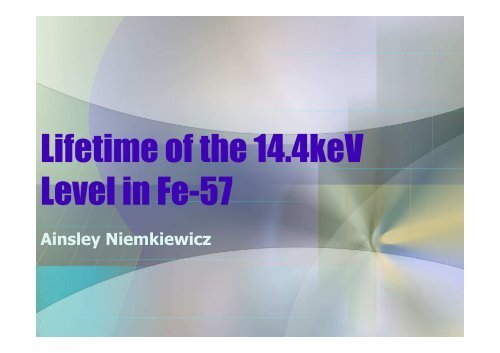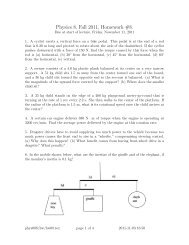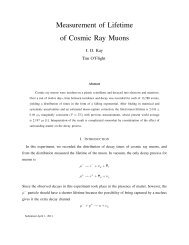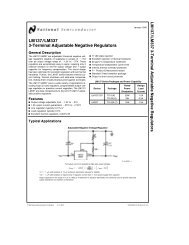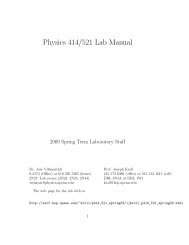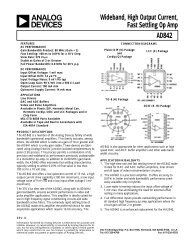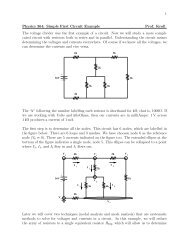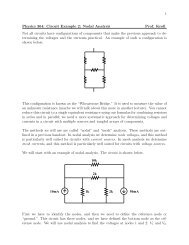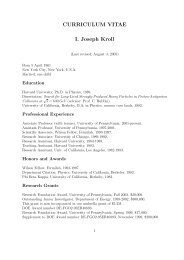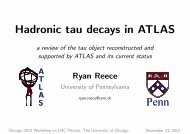Lab 5 Lifetime of the 14.4keV Level in Fe57
Lab 5 Lifetime of the 14.4keV Level in Fe57
Lab 5 Lifetime of the 14.4keV Level in Fe57
Create successful ePaper yourself
Turn your PDF publications into a flip-book with our unique Google optimized e-Paper software.
<strong>Lifetime</strong> <strong>of</strong> <strong>the</strong> <strong>14.4keV</strong><strong>Level</strong> <strong>in</strong> Fe-57A<strong>in</strong>sley Niemkiewicz
Introduction•Co57 decays <strong>in</strong>to<strong>Fe57</strong> at <strong>the</strong> 136keVlevel by k-electroncapture–proton <strong>in</strong> <strong>the</strong> nucleusFigure 1: The decay scheme for Co-57.captures an electron from <strong>the</strong> k shellp + e− → n +υ–#p decreases & #n <strong>in</strong>creases–Co-57 → Fe-57•An electron from <strong>the</strong> l shell fills <strong>the</strong> hole left by<strong>the</strong> electron that was captured–An x-ray is emitted (detected)
Introduction•<strong>Fe57</strong> ei<strong>the</strong>r decaysFigure 1: The decay scheme for Co-57.–directly to <strong>the</strong> ground state and emits a 136keV γ-ray (11%)or–decays to <strong>the</strong> <strong>14.4keV</strong> level and emits a 122keV γ-ray (89%)•Detected γ-ray = “start”•<strong>14.4keV</strong> level decays to <strong>the</strong> ground state ei<strong>the</strong>r–directly, emitt<strong>in</strong>g a <strong>14.4keV</strong> γ-ray or–<strong>in</strong>ternal conversion•nucleus gives some <strong>of</strong> its energy to an electron <strong>in</strong> <strong>the</strong> k shell•<strong>the</strong> electron is ejected from <strong>the</strong> atom•The hole is filled by an l shell electron•X-ray is emitted–Detected γ-ray or x-ray = “stop”
Method•Co57 source–placed on an Fe substrate–located between twosc<strong>in</strong>tillators–faces <strong>the</strong> sc<strong>in</strong>tillator on<strong>the</strong> right (sc<strong>in</strong>tillator 2)•m<strong>in</strong>imize <strong>the</strong> effects <strong>of</strong> absorption<strong>in</strong> <strong>the</strong> substrate•2 Sc<strong>in</strong>tillators–when struck by a particle, absorb <strong>the</strong> energy from that particle–reemit <strong>the</strong> energy <strong>in</strong> <strong>the</strong> form <strong>of</strong> light–Sc<strong>in</strong>tillator 1 (left)•1” thick plastic–Sufficient count<strong>in</strong>g efficiency with 1” thickness–Detects photoelectric and Compton effects wellFigure 2: A diagram <strong>of</strong> <strong>the</strong> apparatusused for this experiment .•Detects <strong>the</strong> 122keV γ-rays emitted when Fe-57 decays from 136keV to <strong>the</strong><strong>14.4keV</strong> level (start)–Sc<strong>in</strong>tillator 2 (right)•1/8” thick plastic with 5% Pb (Bicron)–Increases <strong>the</strong> efficiency for <strong>14.4keV</strong> γ-rays»count<strong>in</strong>g efficiency = 77% for <strong>14.4keV</strong> γ-rays» count<strong>in</strong>g efficiency = 93% for 6.4keV x-rays•density = 1.1g/cm^3•Detects <strong>the</strong> decay <strong>of</strong> <strong>the</strong> <strong>14.4keV</strong> level to <strong>the</strong> ground state (stop)
Method•Photomultiplier tubes (RCA 8575)–Light from <strong>the</strong> sc<strong>in</strong>tillators produces a current–photomultiplier tubes multiply this current 10^7times–Voltage across <strong>the</strong> tube=2.02kV (trials 1&2), 2.12kV(trial 3)•Amplifier-Discrim<strong>in</strong>ators (ELSCINT)–Amplifier ga<strong>in</strong> = 4 (“ga<strong>in</strong> 1”, sc<strong>in</strong>tillator 1), 20 (“ga<strong>in</strong>5”, sc<strong>in</strong>tillator 2)–Discrim<strong>in</strong>ators convert an electronic pulse <strong>in</strong>to astandardized output pulse•only when <strong>the</strong> <strong>in</strong>put pulse amplitude > threshold–Adjust threshold <strong>in</strong> terms <strong>of</strong> sc<strong>in</strong>tillator output bychang<strong>in</strong>g <strong>the</strong> ga<strong>in</strong> and photomultiplier tube voltage•threshold for sc<strong>in</strong>tillator 1 > <strong>14.4keV</strong>•threshold for sc<strong>in</strong>tillator 2 > 6-10keV (weak or strong source)
Method•Time to Amplitude Converter (TAC)–Discrim<strong>in</strong>ator 1 → start <strong>of</strong> <strong>the</strong> TAC–Discrim<strong>in</strong>ator 2 → delay → stop <strong>of</strong> <strong>the</strong> TAC•Delay=200ns•Can see prompt peak/co<strong>in</strong>cidences•Can see <strong>the</strong> decay data left <strong>of</strong> <strong>the</strong> prompt peak (136keV levellifetime)–TAC changes <strong>the</strong> time between <strong>the</strong> start and stoppulses <strong>in</strong>to a voltage•amplitude proportional to time (lifetime)–amplitude conversion = 2,000ns for trial 1 and1,000ns for trials 2 and 3•Multichannel Analyzer (MCA)–sorts <strong>the</strong> data <strong>in</strong>to a histogram–voltages (b<strong>in</strong>s) = x-axis and # <strong>of</strong> counts = y-axis–Conversion ga<strong>in</strong> = 1024 channels
Data & AnalysisGraph 2: Calibration 2 with pulses sent <strong>in</strong> multiples <strong>of</strong> 160ns,without <strong>the</strong> delay, and TAC set at 1,000ns.Graph 1: Calibration 1 with pulses sent <strong>in</strong> multiples <strong>of</strong> 160ns, connected to <strong>the</strong> delay, and TAC set at 2,000ns.• Calibration– Time calibrator sent pulses <strong>of</strong> <strong>in</strong>teger multiples <strong>of</strong> 160ns– 1 st calibration• with <strong>the</strong> delay• TAC = 2,000ns– 2 nd calibration• without <strong>the</strong> delay• TAC = 1,000ns– slope <strong>of</strong> l<strong>in</strong>ear curve fits = conversions from channel # to time
Data & AnalysisGraph 3: Trial 1 exponential decay <strong>of</strong> <strong>the</strong> <strong>14.4keV</strong> level <strong>in</strong> Fe 57 .Graph 4: Trial 1 exponential decay <strong>of</strong> <strong>the</strong> 136keV level <strong>in</strong> Fe 57 .• 3 trials (24 hours, 24 hours, 5 hours)• Exponential curve fit:± xf(x)=Aeτ+ c– A = area under <strong>the</strong> curve, τ = lifetime, and c = background– Po<strong>in</strong>ts were b<strong>in</strong>ned by 4 (<strong>14.4keV</strong> level)• Small # <strong>of</strong> counts <strong>in</strong> each b<strong>in</strong>τ
Data & Analysis3Trial #<strong>Lifetime</strong>12<strong>Level</strong> <strong>in</strong> Fe 57 Weighted Average142.9±0.52(ns)Channel Number (#) 76.25±0.36 150.6±0.9 149.2±3.2Time (ns) 144.7±0.68 140.5±0.84 139.2±2.9<strong>14.4keV</strong>Accepted Value 1 (ns)141.5<strong>Level</strong> <strong>in</strong> Fe 57 Weighted Average12.32±0.14(ns)Channel Number (#) 6.607±0.09 12.33±0.29Time (ns) 12.54±0.17 11.50±0.27136keV13.98±0.4613.04±0.43Accepted Value 1 (ns)12.55Table 1: A table <strong>of</strong> <strong>the</strong> results from <strong>the</strong> graphs.
Data & AnalysisGraph 11: Plot <strong>of</strong> χ 2 vs. <strong>the</strong> lifetime for trial 2,which shows <strong>the</strong> best estimate for <strong>the</strong> lifetime.Graph 9: Plot <strong>of</strong> χ 2 vs. <strong>the</strong> lifetime for trial 1, which shows <strong>the</strong> best estimate for <strong>the</strong> lifetime.• Same exponential curve fit: f(x)= eτ+ c• Fixed lifetime (τ)τ– 120-160ns, steps <strong>of</strong> 5ns• χ^2 values vs. lifetime• M<strong>in</strong>imum=best estimate for <strong>the</strong> lifetime• (m<strong>in</strong>imum χ^2+1)=standard deviation for <strong>the</strong> lifetimeA± x
Data & Analysis2<strong>Lifetime</strong>Trial #1Fe 57 Weighted142.3±0.24Average (ns)Channel 76.59±0.4Number (#) 1Time (ns)145.3±0.78<strong>14.4keV</strong><strong>Level</strong> <strong>in</strong>AcceptedValue 1 (ns)141.5150.3±0.69140.2±0.64Table 2: A table <strong>of</strong> <strong>the</strong> results from <strong>the</strong> χ2 vs. lifetime graphs.• The natural l<strong>in</strong>ewidth <strong>of</strong> <strong>the</strong> <strong>14.4keV</strong> level wasdeterm<strong>in</strong>edh−9−9∆E= = 4.625×10 ± 0.0078×10 evτ• Accepted value=4.66x10^(-9)ev
Uncerta<strong>in</strong>ties• Χ^2 values ≈ (# <strong>of</strong> data po<strong>in</strong>ts - degrees <strong>of</strong>freedom)Trial #<strong>Lifetime</strong>123<strong>14.4keV</strong> χ 2 (experimental) 292.4238.9261<strong>Level</strong> <strong>in</strong>Fe 57 χ 2 (expected)394284289136keV χ 2 (experimental) 6.611126165.8<strong>Level</strong> <strong>in</strong>Fe 57 χ 2 (expected)21207196Table 3: A table <strong>of</strong> <strong>the</strong> χ 2 values and <strong>the</strong> expected values.• Curve fits are okay, but not perfect• Background– flat– adds a constant (c) <strong>in</strong> <strong>the</strong> curve fit equation• Scatter– Ex. particle Compton scatter<strong>in</strong>g <strong>in</strong> one detectorand <strong>the</strong>n <strong>the</strong> scattered photon be<strong>in</strong>g detected by<strong>the</strong> o<strong>the</strong>r detector– Scatter from all over <strong>the</strong> room
Conclusion• Good Results– <strong>Lifetime</strong> <strong>of</strong> <strong>the</strong> <strong>14.4keV</strong> (141.5ns) and 136keV(12.55ns) levels were determ<strong>in</strong>ed• Two methods– Curve fit» 142.9±0.52ns (<strong>14.4keV</strong>)» 12.32±0.14ns (136keV)– Fixed lifetime (m<strong>in</strong>imum value)» 142.3±0.24ns– Natural l<strong>in</strong>ewidth (4.66x10^(-9)ev) <strong>of</strong> <strong>the</strong><strong>14.4keV</strong> level was calculated• 4.625x10^(-9)±0.0078x10^(-9)ev– All <strong>the</strong> values are reasonable compared to knownvalues• some are a few standard deviations away


